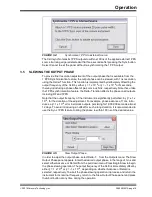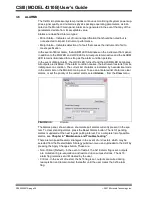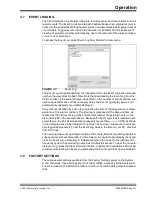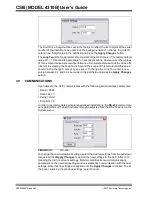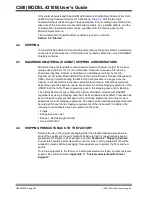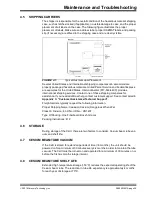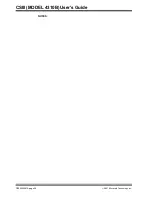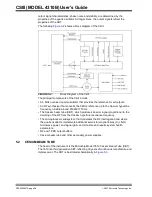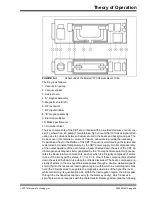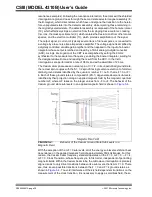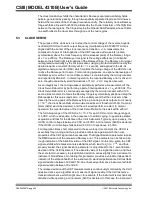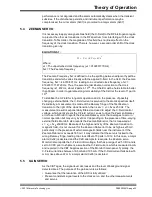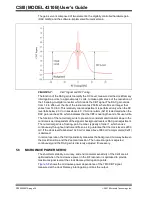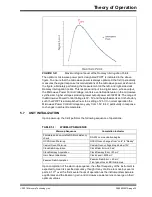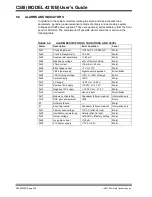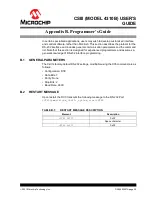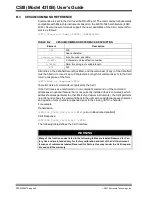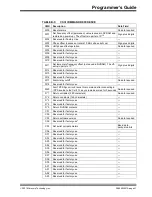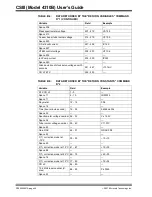
CSIII (MODEL 4310B) User’s Guide
DS50003057A-page 32
2021 Microchip Technology Inc.
The clock transition exhibits the characteristic Ramsey separated oscillatory fields
pattern, generated by passing through two spatially separated regions of microwave
field at the two ends of the U-shaped resonance cavity. The relatively narrow Ramsey
fringe exhibits a line width of 500 Hz, dictated by the Fourier transform of the flight time
between the two regions. The fringe sits atop the broader Rabi Pedestal, whose 10 kHz
line width reflects the travel time through one of the two regions.
5.3
CLOCK SERVO
The purpose of the clock servo is to steer the control voltage of the ovenized quartz
oscillator (OCXO) so that it’s output frequency (multiplied up to 9192631770 Hz) is
aligned with the center of the clock resonance transition, v
C
. A measurement is
composed of a pair of interrogations of the CBT response at two points located
symmetrically about the clock frequency at the steepest points of the Ramsey fringe,
at v = v
C
±250 Hz. The Ramsey error signal is the voltage difference (in millivolts)
between the left and right interrogations of the Ramsey fringe. The Ramsey error signal
is integrated numerically by the microprocessor, using a gain factor determined by the
desired loop time constant (factory set to τ = 1 second), and applied to the 24-bit
digital-to-analog converter (DAC) which controls the tuning voltage of the OCXO so as
to drive the Ramsey error to zero. For monitoring purposes, an exponential average of
the Ramsey error, with a 1 second time constant, is maintained by the microprocessor
and reported by Monitor3. In normal operation, the reported Ramsey error is driven to
zero, though occasionally small fluctuations of 1 mV - 2 mV may be observed.
As an integrity test, the microprocessor periodically performs a measurement of the
Clock Servo Rabi error by performing a pair of interrogations at v = v
C
±5000 Hz. The
Clock Servo Rabi error is continuously averaged by the microprocessor with a 100
second time constant. So far as the Ramsey fringe is symmetrically positioned atop the
Rabi pedestal, this value reads zero. In the unlikely event that the clock servo has
locked to the wrong peak of the Ramsey fringe, producing a clock output error of nearly
ȳ = 10
–7
, the Clock Servo Rabi error would exceed its error threshold of 50 mV, a major
alarm (0x02) would be declared, and the unit would perform a restart. In normal
operation, the reported value of the Clock Servo Rabi error lies well within ±25 mV.
The full tuning range of the OCXO is 5 × 10–7 for an OCXO control voltage range of
0–5 VDC, which is adequate, in the presence of oscillator aging, to guarantee stable
acquisition and lock for the lifetime of the CsIII instrument. Typically, upon delivery, the
OCXO control voltage is between 2 VDC and 4 VDC. A minor alarm (0x08) is declared
if the OCXO control voltage falls below 0.5 VDC or rises above 4.5 VDC.
For integration times short compared to the servo loop time constant, the OCXO is
essentially free running and thus, provides a reference against which the noise
properties of the CBT signal can be measured. The Signal Deviation parameter reports
the RMS deviation of the measured Ramsey error. This parameter can be taken as a
rough indication of the Allan Deviation of the CBT signal. On this time scale, the CBT
signal exhibits white Gaussian noise statistics, which lead to σ
y
(τ) α τ
–1/2
. and thus,
properly scaled, the signal deviation parameter is proportional to the 1-second Allan
deviation of the CsIII instrument. The absolute value of the signal deviation, and thus
the scale factor necessary to predict Allan deviation, varies slightly from instrument to
instrument. Nonetheless, monitoring this parameter provides a valuable independent
indicator of the state-of-health of the instrument. A standard performance CsIII exhibits
signal deviation between 120 and 150. An enhanced performance instrument exhibits
signal deviation between 70 and 90.
The relative deviation of the CBT measurements is continuously monitored by the CsIII
adaptive clock servo algorithm as a measure of signal quality. If the CsIII detects a
transient disturbance, which might occur, for example, if the instrument is mechanically
disturbed while operating, a minor alarm (0x07) is declared. In this case, the instrument
Содержание 4310B
Страница 1: ...2021 Microchip Technology Inc Advance Information DS50003057A CSIII Model 4310B User s Guide...
Страница 26: ...CSIII MODEL 4310B User s Guide DS50003057A page 26 2021 Microchip Technology Inc NOTES...
Страница 38: ...CSIII Model 4310B User s Guide DS50003057A page 38 2021 Microchip Technology Inc NOTES...
Страница 46: ...CSIII Model 4310B User s Guide DS50003057A page 46 2021 Microchip Technology Inc NOTES...
Страница 48: ...CSIII Model 4310B User s Guide DS50003057A page 48 2021 Microchip Technology Inc NOTES...


